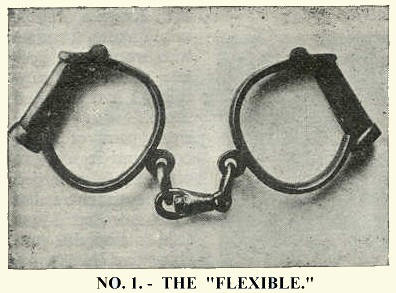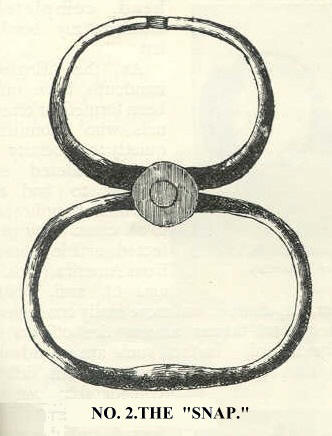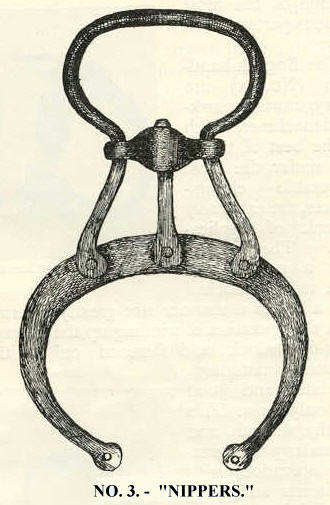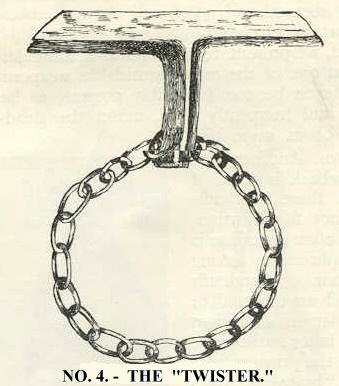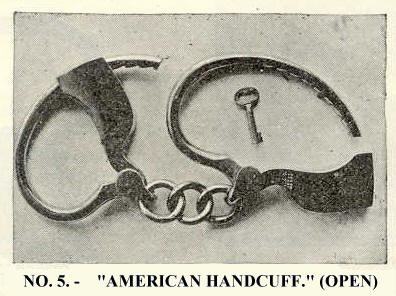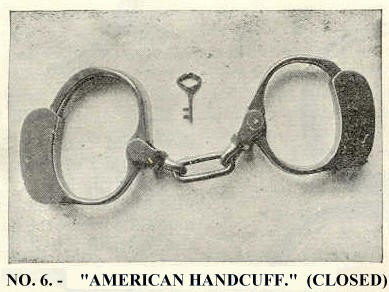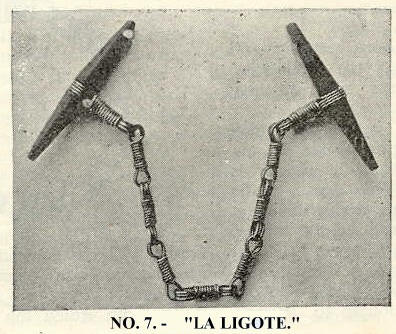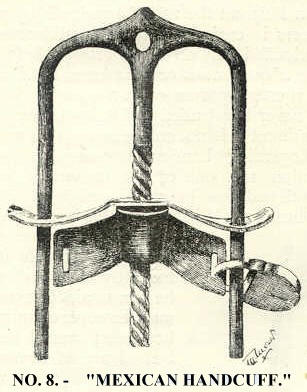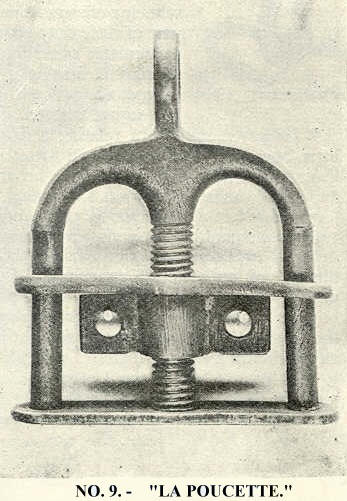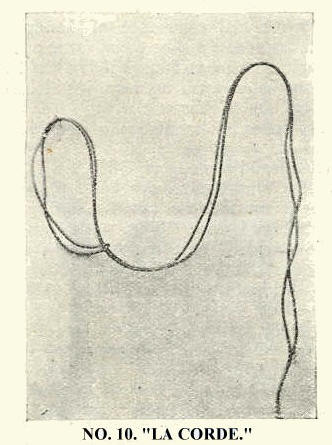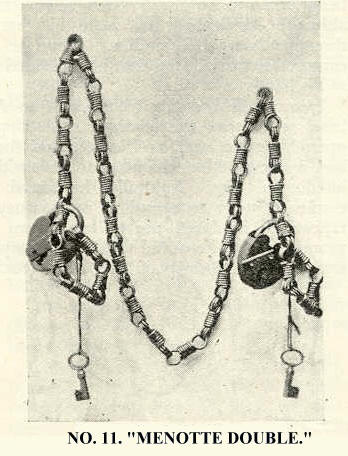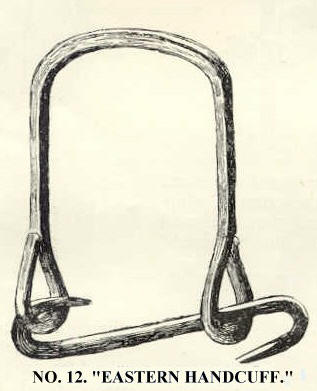| You are here: Weapons > Law Enforcement > Handcuffs > INFO |
The History of Handcuffs:
|
The ordinary connection of ideas between handcuffs and policemen does not need very acute mental posers to grasp, but there is a further connections, a philological one, which is only evident at first sight to those who have made a small acquaintance with the science of words. The word "handcuff" is a popular corruption of the Anglo-Saxon "handcop," i.e., that which "cops" or catches" the hands. Now, one of the most common of the many slag expressions used by their special enemies towards the police is "Copper"- i.e., he who cops the offending member. Strange as it may seem, handcuffs are by no means the invention of these times, which insist on making the life of a prisoner so devoid of the picturesque and romantic. We must go back, past the dark ages, past the stirring times of Greek and Roman antiquity, till we come to those blissful mythological ages when every tree and every stream was the home of some kindly god. In those olden days there dwelt in the Carpathian Sea a wily old deity, known by the name of Proteus, possessing the gift of prophecy, the fruits of which he selfishly denied to mankind. Even if those who wished to consult him were so fortunate as to find him, all their effort to force him to exert his gifts of prophecy were useless, for he was endowed with the power of changing himself into all things, and he eluded their grasp by becoming a flame of fire or a drop of water. There was one thing, however, against which all the miracles of Proteus were of no avail, and of this Arstaeus was aware. So Arstaeus came, as Virgil tells us, from a distant land to consult the famous prophet. He found him on the sea-shore among his seals, basking in the afternoon sun Quick as thought he fitted handcuffs on him, and all struggles and devices were now of no avail. Such was then the efficacy of handcuffs even on the persons of the immortal gods. Having established this remote and honorable antiquity, we are not surprised at the appearance of handcuffs in the fourth century B.C., when the soldiers of a conquering Greek army found among the baggage of the routed Carthaginians several chariots full of handcuffs, which had been held ready in confident anticipation of a great victory and a multitude of prisoners. The nearest approach to a mention that we find after that is in the Book of Psalms: "To bind their kings in chains and their nobles in fetters of iron." But in the Greek, the Latin, Wickliffe's and Anglo-Saxon Bible we invariably find a word of which handcuffs is the only real translation. It is also interesting to note that in the Anglo-Saxon version the kings are bound in "footcops" and the nobles in "handcops." In the early Saxon times, therefore, we find our instrument is familiar to all an in general use, as it has continued to be to this day, But during the fifteenth and sixteenth centuries there is no instance of the use of the word "handcop"; is place is taken by "swivel manacle" and "shackbold," the latter word being often used by Elizabethan authors. Handcuffs, like other things, have improved with time, Up to 1850 there were two kinds in general use in England. One of the forms, most common in the earlier part of this century, went under the name of the "Figure 8." This instrument does not allow the prisoner even that small amount of liberty which is granted by its modern counterpart. It was chiefly used for refractory prisoners who resorted to violence, for it had the advantage of keeping the hands in a fixed position, either before or on the back of the body. The pain it inflicted made it partake of the nature of a punishment rather than merely a preventive against resistance or attack. It was a punishment, too, which was universally dreaded by prisoners of all kinds, for there is no more unbearable pain than that of having a limb immovably confined. The other kind of form known as the "Flexible" (No. 1) resembled in general the handcuffs used every day by detectives.
Contrivances, chiefly the result of American ingenuity for the rapid and effectual securing of prisoners have not been wanting, and among them the "Snap," the "Nippers" (No.3) and the "Twister" must be mentioned.
The "Snap" (No. 2) is the one which used to be the most approved of. It consists of two loops, of which the small is slipped on the wrists of the person to be arrested, the bars are then closed with a snap, and the larger loop is held by the officer. The manner in which the "Twister" (No. 4) was used favors very much of the brutal, and, indeed, the injuries it inflicted on those who were misguided enough to struggle when in its grasp caused its abolition in Great Britain.
Its simplicity and its efficacy, together with the cruelty, have recommended it for use in the wild parts of South America where the upholder of the laws literally travels with his life in his hands. It consists of a chain with handles at each end; the chain is put around the wrists, the handles brought together and twisted round until the chain grips firmly. The torture inflicted by inhuman or inconsiderate officers can easily be imagined. When we see the comparative facility with which the detective slips the handcuffs of the villain in the last act of Adelphi dramas, we are apt to be misled as to the difficulty which police officers meet with in the execution of one of the most arduous parts of their duty.
The English handcuffs (No. 1) are heavy unwieldy, awkward machines, which at the best of times, and under the most favorable circumstances are extremely difficult for application. They weigh over a pound, and have to be unlocked with a key in a manner not greatly differing from the operation of winding up the average eight-day clock, and fastened on to the prisoner's wrists, how, the fates and good luck only know. This lengthy, difficult, and particularly disagreeable operation, with a prisoner struggling and fighting, is to a degree almost incredible. The prisoner practically has to be overpowered or to submit before he can be finally and certainly secured. Even when handcuffed, we present to a clever and muscular ruffian one of the most formidable weapons of offence he could possibly possess, as he can, and frequently does, inflict the deadliest blows upon his captor. Another great drawback is the fact that these handcuffs do not fit all wrists, and often the officer is nonplussed by having a pair of handcuffs which are too small or too large; and when the latter is the case, and the prisoner get the "bracelets" in his hands instead of on his wrists, he is then in possession of a knuckle-duster from which the bravest would not care to receive a blow. On the occasion of my arresting one of the Russian trouble note forgers, a ruffian who would not hesitate to stick at anything I had provided myself with several sized pairs of handcuffs, and it was not until I had obtained the very much needed assistance that I was able to find the suitable "darbies" for wrists. We managed to force him into a four-wheeler to take him to the police-station, when he again renewed his efforts and savagely attacked me, lifting his ironed wrists and bringing them down heavily on my head, completely crushing by bowler hat.
As the English handcuffs have only been formed for criminals who submitted quietly to necessity, it was considered expedient to find an instrument applicable to all cases. The perfected article comes from America (Nos. 5 and 6), and, being lighter, less clumsy, and more easily concealed, finds general favor among the officers of Scotland Yard. In fact, such are its advantages that we must presume that it differs considerably from the Anglo-Saxon "Hancop" and the somewhat primitive article used upon the unwilling prophet of the Carpathian Sea, This and the older kin, to which some of the more conservative of our detectives still adhere, are the only handcuffs used in England.
The ingenious detective of France, where crime and all its appurtenances have reached such a state of perfection, is not without his means of securing his man (No. 7) It is called "La Ligote" or "Le Cabriolet." There are two kinds: one is composed of |
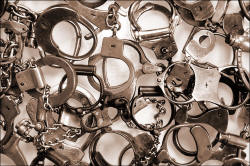 Written and Illustrated by Inspector Maurice Moser,
Late of the Criminal Investigation Department, Great Scotland
Yard
Written and Illustrated by Inspector Maurice Moser,
Late of the Criminal Investigation Department, Great Scotland
Yard 